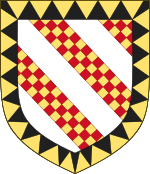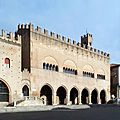House of Malatesta facts for kids
Quick facts for kids Malatestade Malatestiis
|
|
|---|---|
| Noble house | |

|
|
| Country | Italy San Marino |
| Founded | 1295 |
| Founder | Malatesta da Verucchio |
| Final ruler | Pandolfo IV Malatesta |
| Titles |
List
Lord of Rimini
Lord of Ascoli Piceno Lord of Brescia Lord of Bertinoro Lord of Cervia Lord of Cesena Lord of Fano Lord of Fermo Lord of Fossombrone Lord of Iesi Lord of Pesaro Lord of Sansepolcro Lord of Sogliano al Rubicone Podestà of Bologna Podestà of Florence Podestà of Forlì Podestà of Padua Podestà of Pesaro Podestà of Rimini Capitano del popolo of Bologna Capitano del popolo of Florence Papal vicar |
| Estate(s) | Castel Sismondo (Rimini) Rocca Malatestiana (Cesena) |
| Dissolution | 1619 |
| Deposition | 1500 |
The House of Malatesta was a powerful Italian family. They ruled the city of Rimini from 1295 until 1500. They also controlled other towns and lands in the Romagna region of Italy. The Malatestas held important government jobs in cities like Tuscany, Lombardy, and Marche. This family was one of the most important and influential groups during the Late Middle Ages. At their strongest, their lands stretched along the Marche coast. They reached as far as Ascoli Piceno in the south and Bergamo and Brescia in the north.
Contents
History of the Malatesta Family
How the Malatestas Began
The first known member of the family was Rodolfo of Carpegna. He was a fierce fighter, which earned him the nickname mala testa, meaning "bad head." Around the year 1004, he built a castle on a rock near Pennabilli.
In the 11th century, the family owned land in areas like Gabicce Mare and Gatteo. Giovanni Malatesta, who died around 1150, was the first to settle in Rimini. His son married into the powerful Traversari family. They were important leaders in Ravenna and Rimini during the 12th and 13th centuries. By 1186, the Malatesta family became the lords of Torriana.
Giovanni's grandsons, Giovanni and Malatesta I Malatesta, started different branches of the family. Malatesta I became a podestà (a chief magistrate or mayor) in Pistoia in 1228. He also served as podestà of Rimini in 1239 and 1247.
The Rise to Power in Rimini
During a time of big conflicts in Italy, called the Guelphs and Ghibellines wars, Malatesta I first supported the emperor. However, his son, Malatesta da Verucchio, changed sides. He became a leader for the Guelphs, who supported the Pope. In 1295, Malatesta da Verucchio took full control of Rimini. He became the city's signore (lord) after removing his family's rivals.
Malatestino I, another son of Malatesta da Verucchio, became a leader for the Guelphs in Bologna in 1296. He also led them in Florence in 1303. In 1312, he became the lord of Rimini after his father.
Expanding Their Influence
Throughout the 14th and 15th centuries, the Malatesta family ruled many cities. These included Pesaro, Fano, Cesena, Fossombrone, and Cervia. Many Malatesta family members became condottieri. These were military leaders who fought for different Italian states.
One famous Malatesta was Malatesta Novello. He built the amazing Malatestiana Library in Cesena. This library was constructed between 1447 and 1452.

The Most Famous Malatesta
The most well-known Malatesta was Sigismondo Pandolfo Malatesta. He was often in conflict with the Pope over land. He also had a rivalry with another powerful leader, Federico da Montefeltro. In the end, Sigismondo lost almost all his lands. He managed to keep Rimini with the help of the Republic of Venice. He is also famous for building the beautiful cathedral of Rimini, known as the Tempio Malatestiano, starting in 1450.
The End of Malatesta Rule
Sigismondo's grandson, Pandolfo, was forced out of Rimini in 1500. This happened because of Cesare Borgia, a powerful duke. Rimini then became part of the Papal States in 1528. This was after a final attempt by Pandolfo's son, Sigismondo Malatesta, to regain control.
Even after losing Rimini, some Malatesta family members continued to be condottieri in the 16th and 17th centuries. The main branch of the Rimini family ended with Roberto Malatesta, a Jesuit, who died in 1708.
Notable Malatesta Family Members
- Malatesta dalla Penna (died 1248)
- Malatesta da Verucchio (died 1312) - Lord of Rimini, starting in 1295.
First Generation Leaders
- Malatestino 'dell'Occhio' (died 1316) - Lord of Rimini, starting in 1312.
- Paolo 'il Bello' (died 1285)
- Giovanni 'Gianciotto' (died 1304)
- Pandolfo I (died 1326) - Lord of Rimini, starting in 1317.
Second Generation Leaders
- Ferrantino (died 1353) - Lord of Rimini, starting in 1326.
- Ramberto (died 1330)
- Guido the Archpriest (died 1334?)
- Uberto, Count of Giaggolo (died 1323)
- Malatesta II 'Guastafamiglia' (died 1364) - Lord of Pesaro, starting in 1326; and Rimini, starting in 1334.
- Galeotto I (died 1385) - Lord of Rimini and other areas.
Third Generation Leaders
- Pandolfino (died ?)
- Malatestino Novello (died 1335)
- Malatesta 'Ungaro' (died 1364) - Lord of Jesi.
- Pandolfo II (died 1373) - Lord of Pesaro.
- Carlo of Rimini - Lord of Rimini.
- Pandolfo III of Fano (died 1427) - Lord of Fano.
- Andrea of Cesena (died 1416) - Lord of Cesena.
- Galeotto II of Cervia - Lord of Cervia.
Fourth Generation Leaders
- Ferrantino Novello (died 1352)
- Guido (died 1334)
Family Tree of Malatesta
|
|
|
Malatesta I lord of Rimini |
|||||||||||||||||||||||||||||||||||||||||||||||||||||||
|
|
|
|
|
|
|
|
|
|
|
|
|
|
|
|
|
|
|
|
|
|
|
|
|
|
|
|
|
|
|
|
|||||||||||||||||||||||||||
|
|
|
|
|
|
|
|
|
|
|
|
|
|
|
|
|
|
|
|
|
|
|
|
|
|
|
|
|||||||||||||||||||||||||||||||
|
|
|
Pandolfo I lord of Rimini, Pesaro |
|
|
|
|
|
Giovanni lord of Pesaro |
|
|
|
|
|
Malatestino lord of Rimini |
|
|
|
|
|
Paolo capitano in Florence |
|||||||||||||||||||||||||||||||||||||
|
|
|
|
|
|
|
|
|
|
|
|
|
|
|
|
|
|
|
|
|
|
|
|
|
|
|
|
|
|
|
|
|
|
|||||||||||||||||||||||||
|
|
|
|
|
|
|
|
|
|
|
|
|
|
|||||||||||||||||||||||||||||||||||||||||||||
|
|
|
Malatesta II lord of Rimini, Pesaro BRANCH OF PESARO |
|
|
|
|
|
|
|
|
|
Galeotto lord of Rimini, Fano, Cesena, Fossombrone BRANCH OF RIMINI |
|
Ferrantino lord of Rimini |
|
|
|
|
|
Ramberto claimant |
|||||||||||||||||||||||||||||||||||||
|
|
|
|
|
|
|
|
|
|
|
|
|
|
|
|
|
|
|
|
|
|
|
|
|
|
|
||||||||||||||||||||||||||||||||
|
|
|
|
|
|
|
|
|
|
|
|
|
|
|
|
|
||||||||||||||||||||||||||||||||||||||||||
|
|
|
Pandolfo II lord of Pesaro |
|
Ungaro lord of Jesi |
|
Carlo I lord of Rimini, Pesaro, Fano, Cesena |
|
Pandolfo III lord of Fano |
|
Andrea lord of Fossobrone |
|||||||||||||||||||||||||||||||||||||||||||||||
|
|
|
|
|
|
|
|
|
|
|
|
|
|
|
|
|
|
|
|
|
|
|
|
|
|
|||||||||||||||||||||||||||||||||
|
|
|
|
|
|
|
|
|
|
|
|
|||||||||||||||||||||||||||||||||||||||||||||||
|
|
|
Malatesta III lord of Pesaro, Fossombrone, Jesi |
|
|
|
|
|
Galeotto Roberto lord of Rimini |
|
Domenico Novello condottiero |
|
(illeg.) Sigismondo Pandolfo lord of Rimini, Fano |
|||||||||||||||||||||||||||||||||||||||||||||
|
|
|
|
|
|
|
|
|
|
|
|
|
|
|
|
|
|
|
|
|
|
|
|
|
||||||||||||||||||||||||||||||||||
|
|
|
|
|
|
|
|
|
|
|
||||||||||||||||||||||||||||||||||||||||||||||||
|
|
|
Galeazzo lord of Pesaro, Fossombrone |
|
Carlo II lord of Pesaro, Fossombrone |
|
Cleofa Malatesta |
|
Theodore II Palaiologos despot of Morea |
|
Roberto lord of Rimini |
|||||||||||||||||||||||||||||||||||||||||||||||
|
|
|||||||||||||||||||||||||||||||||||||||||||||||||||||||||
|
|
|
|
|
|
|
|
|
|
|
|
|
|
|
|
|
|
|
|
|
|
|
||||||||||||||||||||||||||||||||||||
|
|
|
|
|
|
|
|
|
|
|
|
|
|
|
|
|
|
|
Pandolfo IV lord of Rimini |
|||||||||||||||||||||||||||||||||||||||
|
|
|
|
|
|
|
|
|
|
|
|
|
|
|
|
|
|
|
|
|
|
|
||||||||||||||||||||||||||||||||||||
|
|
|
|
|
|
|
|
|
|
|
|
|
|
|
|
|
|
|
Sigismondo condottiero |
|||||||||||||||||||||||||||||||||||||||
Images for kids
-
Malatesta Castle at Cesena
See also
 In Spanish: Casa de Malatesta para niños
In Spanish: Casa de Malatesta para niños
- House of Malatesta members








